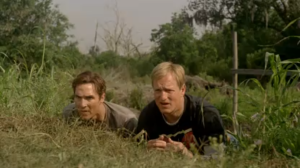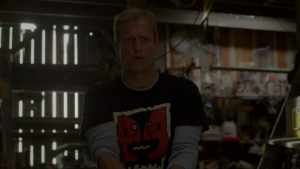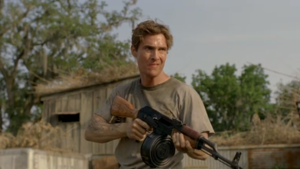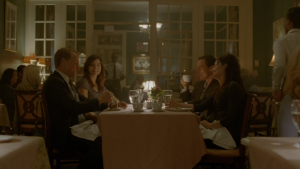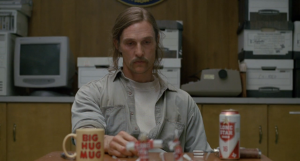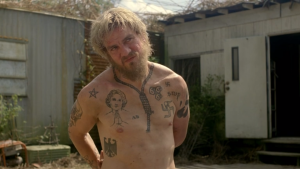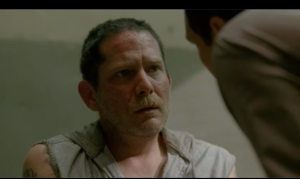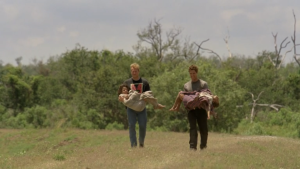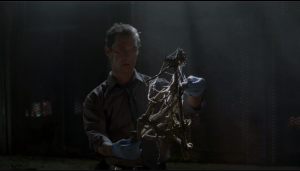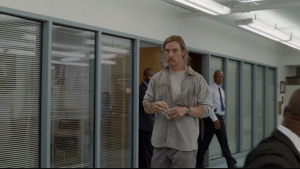“The Secret Fate of All Life”
1995
The fifth episode of the series and last to depict the events of ’95 begins with Rust and Ginger meeting Reggie’s cousin and cook partner—DeWall. The latter declines to do business with Cohle (“I don’t like your face, it makes me want to do things to it.”), but with Marty trailing his vehicle in the aftermath of the meeting, unknowingly leads the two detectives back to his and Reggie’s drug compound found deep in the bayou. Rust and Marty avoid the various traps and hidden explosives before confronting and arresting Reggie in his bathrobe. The supposed killer of Dora Lange mutters a number of cryptic comments to Rust regarding Carcosa and Black Stars, though his ramblings are quickly stopped when Marty reappears from the home and shoots Reggie in the head upon seeing something of horror within the compound. DeWall flees the scene in a panic and kills himself after tripping upon what Cohle later describes as his “homemade cracker-ass security system”.
Rust then investigates the Ledoux Compound that drove Marty into such a rage to find two imprisoned children. The two detectives then stage the scene to hide Marty’s murder and leave behind evidence that would point to a shootout between the two parties. Afterward, the two carry away the children from the compound and are awarded as heroes for their actions. Maggie even forgives Marty for his infidelities, and Rust seems to find a connection with a nurse named Lisa that Maggie set him up with in the intervening years that transition into…
2002
Despite Marty’s somewhat solid footing back in the good graces of Maggie, his relationship with his daughter Audrey has dissolved over the subsequent years. She now sports a rebellious attitude that does not bode well with her traditional father—culminating in a night wherein she is arrested and Marty ultimately slaps his daughter across the face. Meanwhile, Rust’s reputation as the best “assist man” in the state has led to his being called in to interrogate nearly any suspect that the Louisiana PD can’t crack on their own. One of these interrogations leads to Guy Francis—a robber who attempts a plea deal by mentioning the name of The Yellow King.
This sends Rust into a fury, and he slaps the criminal for more evidence in a move that ultimately makes the confession inadmissible. When Rust later demands for Marty to join him in questioning Guy, they find the suspect dead—having committed suicide after a phone call with his “lawyer”. Rust investigates further to find that the phone call was made at an anonymous phone booth way out in the middle of nowhere and that Guy had family who were no doubt threatened by whatever conversation occurred over the phone call in the aftermath of his mentioning the Yellow King name. In the midst of this investigation, Rust finds that one of the two officers guarding Guy’s cell had the last name Childress. Unnerved by Guy’s revelation, Rust begins looking into old case files and examining other reports “made in error” before again investigating the Tuttle Light of the Way School—wherein he finds a collection of eerie angelic drawings and bird/devil trap totems like those left at the crime scene of Dora Lange.
2012
Marty and Rust recount their version of the events in the Ledoux compound to Papina and Gilbough with a drastically different account than the one depicted on screen. Instead, their version favors a wild shootout that led to Marty being able to find a clean shot and murder Ledoux in the back of the head. Marty then further discusses his belief in the detective’s curse over the intervening years after the arrest, when he realizes that so many of the clues to his current state of life were right under his nose the whole time. Moreover, he ponders the idea of letting the good years of life slip through your fingers. At last, he threatens to walk away unless the inquiring detectives reveal their motive—to which Papina and Gilbough admit their suspecting Rust for the most recent murder and pushing the narrative of the Dora Lange case how he sought fit—citing the discovery of Rianne Olivier as their biggest piece of evidence. All this, however, is quickly dismissed by Marty, who believes Rust was reading into them and their materials—rather than the other way around.
Rust, meanwhile, finally concludes his previous philosophical ramblings—but not before the grand finale of detailing the m-brane theory and incorporating some of Nietzsche’s teachings to the two detectives. Rust similarly explains the arrest in a falsified version of the story before launching into a thought-provoking monologue into ideas of time, death, and existence that leave Papina and Gilbough befuddled yet also help succinctly explain for so much of enduring cynicism and hopelessness seen in Cohle’s character throughout previous episodes. More importantly, these ideas illuminate ideas of narrative that have been at the heart of his prior confessions and which ultimately epitomize many of the show’s most prominent themes. Lastly, the detectives finally lay their cards on the table—showing Rust surveillance shots of him captured at the latest Lake Charles crime scene and believing that he may be with holding evidence in his storage shed out near Church Point. They cite the inconsistencies in his story, the death of Billy Lee Tuttle upon his “return” from Alaska, and their ultimate theory that he may have been pushing the agenda of the case. All of this is more or less laughed away by Cohle, as he finally leaves the interrogation room refusing to give them access to his shed—thanking them for the beer, but “beyond that, you wasted my fuckin’ day, company man”.
———————————————————————————————————————————-
REVIEW
While the previous episode contains the show’s most memorable action sequence through the tracking shot of Rust’s escape from the housing project, “The Secret Fate of All Life” contains what is perhaps the show’s most memorable writing from a storytelling standpoint. From Rust’s philosophical expansion of Ledoux’s “time is a flat circle” comment, to the false narrative employed by 2012 Rust and Marty against the incredible set-piece of their raid on the compound, to the excellent transition out of ’95 and into ’02, “The Secret Fate of All Life” demonstrates exactly why the episode deserves the many writing accolades for which it achieved.
The conclusion of the ’95 storyline and the hunt for Ledoux marks a major turning point for both the larger story and characters. Using the Louisiana backwoods and bayou setting to incredible atmospheric effect and building up the detectives’ raid upon the compound with an excellent escalation of suspense—from their spotting the bird traps, the trip wire explosives, their refusal to call in back up, their slow stalking of Ledoux—the raid itself starts off this riveting episode with a bang.
Ledoux’s cryptic and haunting comments to Cohle—mentioning all the series’ mythological touchstones from Carcosa, to the Black Stars, and culminating in his “time is a flat circle” comment—offer further tension in the midst of Marty’s own investigation into the compound’s contents, where he finds two kidnapped and traumatized children. After now multiple moments depicting Marty’s immediate response to conflict as explosive violence, he exits the compound and shoots Ledoux in the head in cold-blooded murder. Though Cohle justifies Marty’s murder in stating that Ledoux deserved to die and that he’s glad to see Marty “commit to something”, the two must immediately clean up the crime scene to leave evidence for a different story. Within this incredible sequence, Marty and Cohle’s testimonials from 2012 are expertly weaved through the editing to be simultaneously juxtaposed against the real events of ’95 that are as cinematic and compelling as they are thematically relevant.
With so much of the series’ main thematic focus on being on the idea of narrative—the stories Marty and Rust tell themselves about their own identity, their story to Papania and Gilbough about the story of ’95, the mythological touchstone of the Yellow King being a reference to Chambers’ “The King in Yellow” (a story about a story that drives people insane)—this sequence which so expertly marries the editing, dialogue, and character demonstrates all of these ideas to unifying and compelling effect.
Moreover, the “time is a flat circle” comment that has grown to become one of the show’s most memorable and quoted phrases serves as a perfect transition and expansion of this theme from the ’95 storyline, to 2002, and the present. For despite catching whom they believe to be Dora Lange’s killers, and being rewarded as such, so many of the same struggles previously seen still remain. Maggie reluctantly accepts Marty back into their familial life, only for him to remain as hypocritical and confused as ever. For after having his own affairs and sexual deviances, Marty finds himself belittling his thirteen-year-old daughter and eventually slapping her in the face for her behavior and refusal to adhere toward how he wants a woman to behave.
Like murdering Ledoux upon seeing his crimes, Marty’s slaps his daughter in the face in yet another demonstration of his explosive, violent response to conflict. Likewise, when his daughter protests that Marty can’t press charges against the older boys, he responds, “I can do whatever I goddamn want to those boys”—yet again demonstrating his abuse of authoritarian and police power as a detective with a badge. Like with his terrorizing Lisa for having an affair, like his shooting Ledoux in the face, and now like slapping his daughter in the face—the detective’s repetitive response exemplifies the “time is a flat circle” idea that he is doomed to live out these horrible choices within himself time and time again—despite whatever small victories he may have. Though he does admit in the 2012 interviews that “infidelity is one kind of sin, but my one true failure was inattention, I realize that now”, Marty appears destined to repeat his same mistakes time and time again.
Likewise, despite Rust’s apparent victory against Ledoux, he learns that the events of the Yellow King have returned in 2002 during his interrogation of Guy Francis. The mention of the Yellow King returns him back to the tree in Erath where he once found Dora Lange (and finds a flat circle of knots within the trunk), along with the missing picture of Stacy Gerhart, and his return to the Light of the Way school from Episode Three. And upon further investigation into the school, he finds disturbing pictures of angels (mentioned in Dora’s diary) and an array of twig totems like those found at the Ledoux compound and numerous other locations connected with the King. When the detectives ask Marty what happened to Rust and his girlfriend, he responds: “What always happens between men and women: reality”. Again, there’s meaning to be interpreted here with the false narrative of Rust being able to live like a normal, married man only for the reality of his job and personality to supersede any chance of making that a reality.
Much of this philosophy incorporating elements of Nietzsche’s eternal recurrence helps give some insight into Rust’s unstable psychology and cynical attitude toward resolution that has been peppered into prior episodes. It’s worth noting that in the shot of the detectives rescuing the kids from the Ledoux compound, with each carrying one of the two children, Rust is carrying the dead boy in his arms rather than the afflicted girl that is in Marty’s–perhaps representing Rust’s own dead child–and his continual failure to save the child’s life. Rust repeats this idea in his interview with Papina and Gilbough that those kids will always be there in that compound, that his interview with the detectives may have happened or will have happened again, and these evils that have haunted his life so far (like the death of his daughter and inability to maintain a stable marriage) will only continue to recur in endless cycles of time. As further outlined in more abstract concepts regarding eternity’s creation of time in order to have something kill, this horribly unnerving idea is what lends the episode its title as being the secret fate to all life.
Nonetheless, this episode does mark the turning point for the typical structure of the series’ episodes by having Papina and Gilbough finally lay out their cards on the table that they do indeed believe Rust may responsible for the most recent Lake Charles murder and may be withholding evidence within his storage shed near Church Point. Rust insults them for the accusation and leaves the confession room—disappointed in not being able to glean any new information about the murder. (It’s worth noting at this point that Rust’s drinking throughout the interviews will make his interrogation inadmissible.) Still, with the ’95 storyline more or less wrapped up and much hinting toward the break between Marty and Rust in ‘02, the episode’s conclusion leaves the viewer with more questions than ever toward finding the true identity of the killer and wrapping up the case of Dora Lange.
